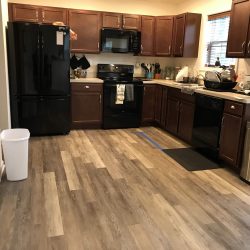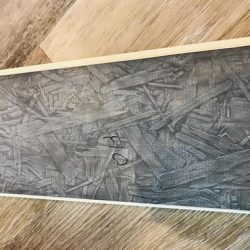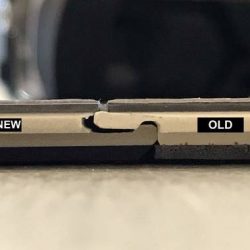This LVP was installed in the kitchen of a new house. Within 6 months of installation, the floor buckled between the sink and the refrigerator. The retailer ordered replacement material and the planks were replaced in the buckled area.

The installer couldn’t get the planks to fit correctly without gaps on the side and end joints so he covered the gaps with painters tape and notified the retailer. At that point, the retailer hired an inspector to determine the cause.
The inspector asked the homeowner if any attic stock was available and was directed to a couple of boxes in the garage. The homeowner didn’t know if the boxes contained the new or old planks.
Now the inspector had to determine which planks were old and which were new. Fortunately, it was obvious which planks were old because the black rubber backing on the old planks had a white dusty OSB outline, and the new planks had a brown rubber backing that was dust and dirt free.

The Inspector’s Findings:
The inspector connected old and new planks together on a flat surface and found the length, width, height, and backing thickness was identical, however, the tongue and groove configuration did not match up and could not be engaged.
Since the T&G could not be properly engaged, it left a gap measuring 1/32″ wide down the length and at the end of the planks.

The same Manufacturer, Pattern, and Color names were stamped on the cartons indicating the proper product was ordered for the repair. It was later confirmed that the manufacturer had recently changed the T&G configuration.
This floor was successfully repaired with the existing planks and available attic stock using a method called
Joining A and Z Profiles
This repair method is explained in CFI University’s Luxury Vinyl Online Course.

![]()
Certified Flooring Inspectors University:
Ricky Bunker 843-222-1029
Linda Lockwood 609-660-1717